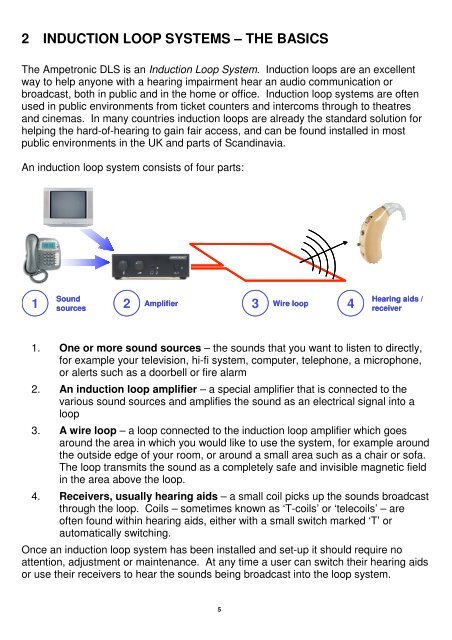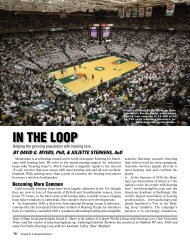Domestic Loop System (DLS) - Hearing Loop
Domestic Loop System (DLS) - Hearing Loop
Domestic Loop System (DLS) - Hearing Loop
You also want an ePaper? Increase the reach of your titles
YUMPU automatically turns print PDFs into web optimized ePapers that Google loves.
2 INDUCTION LOOP SYSTEMS – THE BASICS<br />
The Ampetronic DLS is an Induction <strong>Loop</strong> <strong>System</strong>. Induction loops are an excellent<br />
way to help anyone with a hearing impairment hear an audio communication or<br />
broadcast, both in public and in the home or office. Induction loop systems are often<br />
used in public environments from ticket counters and intercoms through to theatres<br />
and cinemas. In many countries induction loops are already the standard solution for<br />
helping the hard-of-hearing to gain fair access, and can be found installed in most<br />
public environments in the UK and parts of Scandinavia.<br />
An induction loop system consists of four parts:<br />
Sound<br />
sources<br />
1 2 Amplifier<br />
3 Wire loop<br />
4<br />
<strong>Hearing</strong> aids /<br />
receiver<br />
1. One or more sound sources – the sounds that you want to listen to directly,<br />
for example your television, hi-fi system, computer, telephone, a microphone,<br />
or alerts such as a doorbell or fire alarm<br />
2. An induction loop amplifier – a special amplifier that is connected to the<br />
various sound sources and amplifies the sound as an electrical signal into a<br />
loop<br />
3. A wire loop – a loop connected to the induction loop amplifier which goes<br />
around the area in which you would like to use the system, for example around<br />
the outside edge of your room, or around a small area such as a chair or sofa.<br />
The loop transmits the sound as a completely safe and invisible magnetic field<br />
in the area above the loop.<br />
4. Receivers, usually hearing aids – a small coil picks up the sounds broadcast<br />
through the loop. Coils – sometimes known as ‘T-coils’ or ‘telecoils’ – are<br />
often found within hearing aids, either with a small switch marked ‘T’ or<br />
automatically switching.<br />
Once an induction loop system has been installed and set-up it should require no<br />
attention, adjustment or maintenance. At any time a user can switch their hearing aids<br />
or use their receivers to hear the sounds being broadcast into the loop system.<br />
5



